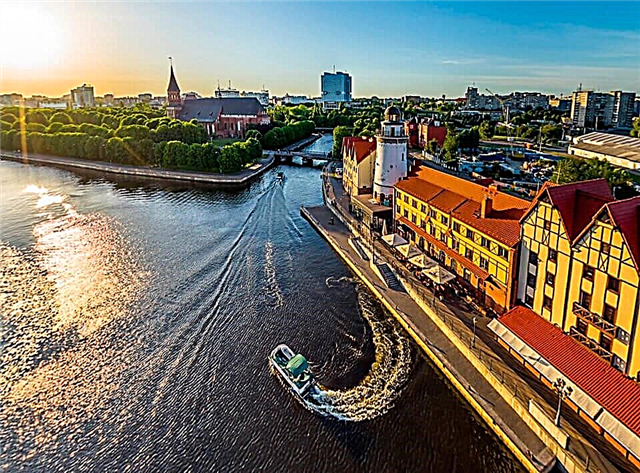The ancient Kostroma monastery has almost 600 years of history and was founded by the Monk Elder Nikita. These centuries have contained many joyful and tragic events. Today the spiritual center of the Kostroma lands has been completely restored and restored. And tourists and pilgrims who come to the ancient Russian city strive to see the miraculous icon of the Fedorov Mother of God, which is known to all Orthodox Christians, stored here.
The history of the monastery in the XV-XVIII centuries
The very first monastery on the outskirts of Kostroma was for men. It was created by one of the students of Sergei Radonezhsky and his relative Nikita, who, already being an old man, came to the Kostroma land from Borovsk. It happened in 1426. The exact date of the death of this Christian ascetic has not been preserved, but it is known that the respected Nikita of Kostroma was buried in the very first cathedral of the monastery he created.

Epiphany-Anastasiin Monastery from a bird's eye view
At first, all the buildings in the monastery were made of wood, and the powerful monastery walls protected Kostroma from enemy raids. Only in 1559 the brethren raised the necessary funds and received permission from the Moscow Metropolitan Macarius to build the first stone church. The five-domed Epiphany collection was built under the leadership of Abbot Isaiah (Shaposhnikov) for six years and consecrated in 1565. Its main donor was the cousin of the Russian Tsar John IV, the penultimate appanage Russian prince, Vladimir Staritsky.
4 years later, Staritsky with an army went to the defense of Astrakhan and on the way stopped at the Kostroma monastery. The monks and the abbot gave the sovereign's relative a warm welcome, which, however, became the reason for the court intrigue. The tsar's entourage slandered Staritsky, and by order of Ivan the Terrible he was killed in the same year in the Aleksandrovskaya Sloboda. The monastery also found itself in terrible disgrace. In 1570, most of the inhabitants and the abbot Isaiah were executed, burying the latter in the basement of a stone cathedral on the monastery territory.

View of the buildings of the Epiphany-Anastasi Monastery
However, time passed, and, despite the difficult trials, the monastery grew and its influence increased. Therefore, in the 16th century, two women's cloisters were attributed to the male monastery - the Exaltation of the Cross and Anastasiina, named after the founder - the daughter of Dmitry Donskoy.
The beginning of the 17th century turned out to be a very difficult and ruinous Time of Troubles for Russia. In the last days of 1608, the troops of False Dmitry II, led by Alexander Lisovsky, entered the city, broke through the defenses and occupied the monastery. For the fact that the monks and monastery peasants were faithful to the oath given to the Russian Tsar Vasily IV, they were killed, and the monastery itself was plundered. The names of the perished inhabitants and Kostroma residents are honored by parishioners today.

Later, when the troubles were over, a lot of construction began throughout the city. Two new monastery churches and a side-altar to the Epiphany Cathedral appeared, a belfry and a stone monastery fence with towers were built, which made the monastery a real fortress.
In the 60s and 70s of the 17th century, an artel of isographers, under the leadership of the famous icon painters Sila Savin and Gury Nikitin, decorated the main monastery church with frescoes. Unfortunately, these wall paintings have not survived. At the same time, the famous fresco icon with the face of the Mother of God was created on the southwestern tower of the stone monastery wall.

Epiphany Cathedral with golden domes
At the beginning of the next, XVIII century, a whole series of Peter's transformations took place, and the pace of monastic life slowed down. There was no money to build new buildings, and the number of monks decreased. Only in 1752-1760. at the expense of E.M. Saltykova, a new one-domed Nikolsky ("Saltykovsky") temple was built here. So the grieving widow wished to perpetuate the grave of her husband, Major General M.P. Saltykov.
Since 1779, the nationwide veneration of the icon-fresco of the Mother of God began. The reason for this was a large fire that engulfed the entire city and caused considerable damage to the monastery. Many buildings then burned down in the fire, but the Smolensk fresco icon was not damaged at all. Since that time, the inhabitants of Kostroma have come to believe in its miraculous properties.

Epiphany Cathedral with golden domes, Epiphany Anastasiin Cathedral of the Epiphany with dark domes
The life of the monastery in the XIX-XX centuries
Since 1814, for 33 years, the students of the Theological Seminary lived and received their education in the monastery, and the abbots of the monastery were considered its rectors. During these years, through the efforts of Archimandrite Macarius (Glukharev), one of the towers of the monastery fence was rebuilt into a beautiful one-domed church, which was dedicated to the Smolensk Icon of the Mother of God.
In the fall of 1847, a difficult test awaited the inhabitants of the monastery - another big fire, which almost completely destroyed all the monastery buildings. The damage was enormous, the monastery had to be closed, and the monks were transferred to the Bogoroditsky Igritsky monastery located not far from Kostroma. And only in 1863, 16 years later, they decided to restore the monastery, but already as a female one. He was named Epiphany-Anastasin, and his first abbess was appointed Abbess Maria (Davydova), under whose leadership the restoration of the monastery destroyed by fire began.

Church of the Smolensk Icon of the Mother of God. In the background: the bell tower on the left, the Epiphany Cathedral on the right
This difficult work took about fifteen years, and the monastery was rebuilt only by the 1880s. On its territory, old buildings were restored and new ones were erected. And the monastery became famous among local residents as a center of Christian ministry. At the beginning of the 20th century, courses for sisters of mercy and the very first hospital in Russia that helped rural residents worked there.
In 1918, the new Soviet state closed the monastery, and its main church, the Epiphany Cathedral, remained a parish church for another six years. In these difficult years, Vasily Razumov was a priest here. Later he was arrested, convicted, and in 1937 he was shot.

Monastery bell tower
In 1925, the Kostroma regional archives were placed in the former cathedral. Over the next several decades, the walls of the monastery were destroyed, and the Nikolskaya church and the chapel were dismantled altogether. The cathedral was dilapidated and destroyed without proper maintenance and repair work. But the worst damage was caused by a fire that happened in the regional archive in 1982. Then the fire destroyed the last frescoes of the 17th century.
The decision to revive the monastery was made in 1990, and the next year the first nuns from Estonia... At the same time, the consecration of the cathedral took place, and in the diocese it was given the status of a cathedral. A little later, one of the main Orthodox shrines was transferred to this temple - the icon-painting image of the Fedorov Mother of God, which is considered the ancestral shrine of the royal dynasty of the Romanovs. And in the early 2000s, a monument to the patron saint of the city of Kostroma, Fyodor Stratilat, was erected on the monastery territory.

Monastery gate
Architectural monuments on the territory of the monastery
The majestic five-domed Epiphany Cathedral is the oldest stone building in Kostroma, preserved to this day (1565). Researchers believe that Moscow craftsmen took part in its construction. This four-pillar temple is distinguished by the grandeur of forms and proportions, and its facades are completed by graceful keeled zakomaras. True, at a later time, the podzakomarny cover was replaced with a practical hipped one. Over the course of a long history, several additions were made to the cathedral, and the largest construction work took place in 1864-1869. Now the cathedral has four thrones, and it is in it that the famous image of the Fedorov Mother of God is kept.
In addition, on the territory of the monastery there is a one-domed church dedicated to the Smolensk Icon of the Mother of God (1825). The one that was rebuilt from a tower on a stone wall. At one time it was erected with money allocated by the wealthy merchant of Kostroma F.M. Obryadchikov, and the construction was supervised by the city architect P.I. Fursov. Initially, the temple was built in the classicism style, but after a fire in 1887, it was rebuilt in the Russian-Byzantine style.

Domes of the Epiphany Cathedral (golden domes), Epiphany Anastasiin Cathedral (dark domes)
The high picturesque bell tower (1864) stands out on the territory of the monastery. It has a hipped roof with a graceful gilded dome and a clock in one of the openings for ringing.
Current state and visiting regime
The monastery is active. More than a hundred nuns and abbess live permanently in it, and church services are performed daily. On the territory of the monastery are the Theological Seminary and the administration of the Kostroma diocese. In addition, the monastery has an almshouse for elderly women and a shelter where orphan girls live and study.

Epiphany Anastasiin Cathedral
Access to the monastery territory for strangers is prohibited. Pilgrims and tourists can only visit the chapels and external entrances of the Epiphany Cathedral.
How to get to the monastery
The monastery is located on the street. Simanovsky (Epiphany), 26.
By car. The road from the capital to Kostroma takes 4.5-5 hours (346 km) and runs along the Yaroslavl highway and the M8 highway (Kholmogory). In Kostroma on the road bridge you need to move to the left bank of the Volga, turn onto st. Sovetskaya and take it to Susaninskaya Square. Simanovskiy street leads from the square to the monastery.

Abbot building
By train or bus. From the Yaroslavsky railway station to Moscow trains reach Kostroma in 6.04-6.35 hours. In addition, from the Central Bus Station of the capital, located near the Shchelkovskaya metro station, you can get to Kostroma by regular buses (7 trips a day). This journey takes 6.50 hours. The Kostroma bus station is 1 km away from the railway station. Bus No. 1 and trolleybuses No. 2, 7 (stop "Ul. Pyatnitskaya"), as well as bus No. 2 (stop "Fabrika-kuhnya") run around the city to the monastery.
Attraction rating:











